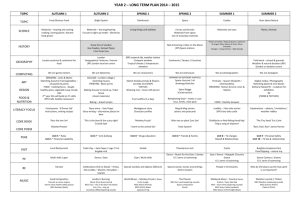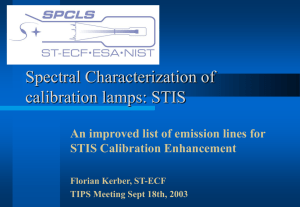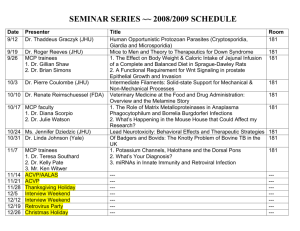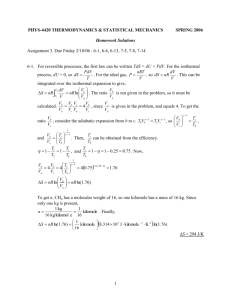TIPS Meeting 18 September 2003, 10am, Auditorium
advertisement
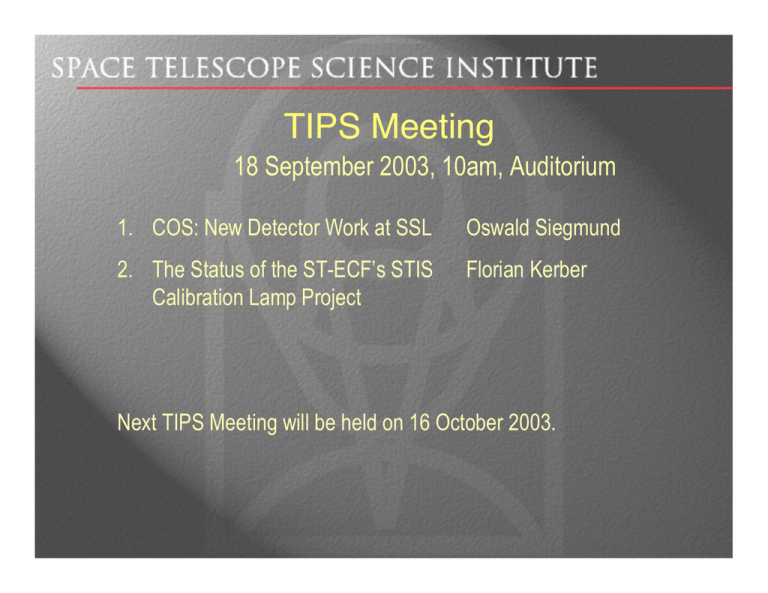
TIPS Meeting 18 September 2003, 10am, Auditorium 1. COS: New Detector Work at SSL Oswald Siegmund 2. The Status of the ST-ECF’s STIS Calibration Lamp Project Florian Kerber Next TIPS Meeting will be held on 16 October 2003. High performance microchannel plate detectors for UV/visible Astronomy Dr. O.H.W. Siegmund Space Sciences Laboratory, U.C. Berkeley Work funded by NASA grants, NAG5-8667, NAG5-11547, NAG-9149 Space Sciences Lab, UC Berkeley, CA, USA 1 Advanced Advanced MCP MCP Sensors Sensors for for Astrophysics Astrophysics Existing Existing Detectors Detectors High QE alkali halide cathodes (CsI, KBr) with ~50%QE covering 10nm - 185nm MCP’s with 12µm to 6µm pores, background 0. 2 events cm-2 sec-1 Cross-delay line readouts with 15µm resolution, 90 x 20mm, 65mm formats COS 2 x 90mm x 10mm XDL detector GALEX 65mmsealed tube XDL detector Space Sciences Lab, UC Berkeley, CA, USA 2 Advanced Advanced MCP MCP Sensors Sensors for for Astrophysics Astrophysics COS COS FUV FUV Detector Detector and and Electronics Electronics Space Sciences Lab, UC Berkeley, CA, USA 3 Advanced Advanced MCP MCP Sensors Sensors for for Astrophysics Astrophysics COS COS FUV FUV Detector Detector QE QE CsI cathodes on FUV02 flight detector compared with COS spec Segment B Segment A 0.5 0.6 Requirements QE post miniscrub2 Requirements QE post miniscrub2 0.4 Quantum Efficiancy Quantum Efficiency 0.5 0.4 0.3 0.3 0.2 0.2 0.1 0.1 0 1100 1200 1300 1400 1500 1600 1700 0 1100 1800 WAVELENGTH (Å) Space Sciences Lab, UC Berkeley, CA, USA 4 1200 1300 1400 1500 1600 WAVELENGTH (Å) 1700 1800 Advanced Advanced MCP MCP Sensors Sensors for for Astrophysics Astrophysics COS COS Detector Detector Event Event Rate Rate Performance Performance COS FUV local and global count rate performance is better than FUSE, and exceeds specs. Global count rate throughput Gain and PHD vs. Localized Input Rate (Single 25µm x 500µm Slit) 100000 2 80000 Relative Gain Relative PH width 1.6 Relative Gain Digital Event Counter (cps) 1.8 1.4 1.2 1 60000 40000 20000 0.8 0.6 0 0.1 1 10 100 Microchannel Pore Input Rate (cps) Space Sciences Lab, UC Berkeley, CA, USA 0 50000 100000 150000 Fast Event Counter (cps) 5 200000 250000 Advanced Advanced MCP MCP Sensors Sensors for for Astrophysics Astrophysics COS COS Detector Detector Resolution Resolution COS detector co-added image of 10µm pinholes on 500µm centers & 25µm x 500µm slits 200µm apart. Pixels are 6µm x 25µm or ~15,000 x 400 format per segment. COS FUV01 Segment A - Pinhole Resolution vs. X 100 X FWHM(µm) 80 COS FUV detector resolution is ~20µm x 30µm FWHM 60 40 20 0 0 2000 4000 6000 8000 10000 12000 14000 X centroid (pxl) Space Sciences Lab, UC Berkeley, CA, USA 6 16000 Advanced Advanced MCP MCP Sensors Sensors for for Astrophysics Astrophysics Developing Developing Detector Detector Prospects Prospects Raw flat field image Shows MCP multi -fibers, but after thermal correction and division data looks statistical (with ~4400 cnts/resel we get S/N ~60:1). Using FPSPLIT with 4 co-added images each with 60:1 S/N we get S/N of ~100:1 which is in close accord with photon statistics. For analysis see memo by Wilkinson/Penton/Vallerga/McPhate. Space Sciences Lab, UC Berkeley, CA, USA 7 Photocathode Development GaAs Photocathodes on windows, & Diamond Photocathodes on Silicon & Si MCP’s Polycrystalline boron doped diamond, band gap - 5.47 eV (227 nm) - Solar blind. Hydrogenated diamond is air stable (<10% drop in 18 hours) and is very robust. GaAs QE up to 50% in the red now possible, low background ≈10 events/sec @-20°C Time response <1ns, for Interferometry, Lidar,Molecular fluorescence. 1 Diamond coated Silicon MCP Cs activated QDE 0.1 0.01 0.001 0 #2 #1 #5 #8 21201 Si MCP 20801 20501 Pre-hydrogenated values 500 1000 1500 2000 Wavelength (Å) GaAs photocathode UV efficiency Space Sciences Lab, UC Berkeley, CA, USA Diamond Photocathodes on Silicon and Si MCP’s 8 GaN Photocathodes 0.6 60 Quantum Efficiency Quantum Eficiency (%) NIST CsTe diode 0.5 NW-BH071#3 NW-JG238#2 SVT3102#2 SVT2702S-52803 NW-JG238S#3 opaque GALEX NUV01 CsTe CsI #3 2/99 20° 0.4 0.3 0.2 50 40 30 20 10 0.1 semitransparent 0 1500 0 2000 2500 3000 3500 4000 150 4500 250 300 350 400 450 Wavelength (nm) Wavelength (Å) Fig.2. Measured QE of GaN samples on sapphire (300µm) after cesiation, for semitransparent (corrected for substrate transmission) & opaque modes Fig.1. Measured quantum efficiency of CsI on MCP’s, CsTe semitransparent (NIST) on MgF2 window and CsTe semitransparent (GALEX) on thick UV silica windows. Space Sciences Lab, UC Berkeley, CA, USA 200 9 Silicon MCP Developments Silicon MCP’s Hexagonal pore Si MCP with ~7µm pores, >75% open area Silicon MCP’s are made by photo-lithographic methods Photolithographic etch process - very uniform pore pattern No multifiber boundaries & array distortions of glass MCP’s Large substrate sizes (100mm) OK, with small pores (5µm) High temperature tolerance - CVD and “hot” processes OK UHV compatible, low background (No radioactivity) Development in collaboration with Nanosciences. Typical Silicon microchannel plates in test program 25mm diameter (75mm currently feasible) 40:1 to 60:1 L/D (>100:1 possible) 7µm pore size, hexagonal and square pore ~2° bias and 8° bias, resistances ~GΩ, to <100MΩ possible Working on processing techniques to improve uniformity Techniques for gain & QE enhancement under investigation 8cm Si MCP on 100mm substrate Space Sciences Lab, UC Berkeley, CA, USA 10 Silicon MCP Performance Characteristics Gain & PHD very similar to glass MCP’s, stacks of Si MCP’s (4) with gain up to 106 QE is similar to good bare glass MCP’s (COS, EUVE, 12/10/6µm) The background rate is lower (0.02 events cm-2 sec-1) than any glass MCP Gain and response uniformity are reasonably good. No “hex” modulation! 0.2 12/10µm COS Si MCP Bare glass Si Hex MCP 0.15 QDE 6µm pore MCP 0.1 0.05 0 200 400 600 800 1000 1200 1400 Wavelength (Å) QDE for Si & bare glass MCP’s vs Wavelength Space Sciences Lab, UC Berkeley, CA, USA Contrast enhanced image of the fixed pattern response to a Hg vapor lamp with a stack of 4 Si MCP’s. ~14mm area, 107 counts, ~50µm resolution XDL. 11 Cross strip anode readout 32mm x 32mm XS anode, 0.5mm period Cross strip is a multi-layer cross finger layout. Fingers have ~0.5mm period on ceramic. Charge spread over 3-5 strips per axis, Event position is derived from charge centroid. centroid. Can encode multiple simultaneous events. Fast event propagation (few ns). Anodes up to 32 x 32mm have been made Signals are routed to anode backside by hermetic vias Packaging can be compact with amp on anode backside Overall processing speed should support >> MHz rates Compact and robust (900° (900°C). Bottom fingers Space Sciences Lab, UC Berkeley, CA, USA 12 Cross Strip Anode Electronics Chain Basic encoding sequence Small, low power ASIC encoding with sparsification reduces data throughput requirements Cross strip anode position encoding electronics test-bed system. All signals amplified and digitized. Can choose up to 12 bits per signal. Space Sciences Lab, UC Berkeley, CA, USA Anode backside showing the external board where preamplifier chips are mounted. 13 Cross Strip Anode Readout Outstanding Spatial Resolution/Linearity ~7µm pores are resolved, <3 µm electronic resolution with 10 bit encoding electronics Image linearity is ~1µm level and shows pore misalignments and multi-fiber boundaries Gain required is <4 x 105, allows higher local event rates than normal readouts Lower gain means longer overall MCP lifetime due to reduced charge extraction. Small zone of a single 12µm 160:1 L/D MCP at 2x105 gain showing apparent displacement of pore images at multifiber boundaries Flood image of 12µm pore MCP pair at 4 x 106 Gain, ≈1mm square area. Space Sciences Lab, UC Berkeley, CA, USA 14 Resolution Resolution of of Cross Cross Strip Strip MCP MCP Sensors Sensors Gain 1.3 x 106 Air force mask on 6µm pore MCP pair with cross strip readout Space Sciences Lab, UC Berkeley, CA, USA Air force mask on Single 6µm pore MCP optical image 15 Advanced Advanced MCP MCP Sensors Sensors for for Astrophysics Astrophysics GALEX GALEX Early Early Observations Observations 60mm XDL detectors with CsI and CsTe photocathodes, Launched 6/03 M101 M83 Near-UV Channel Space Sciences Lab, UC Berkeley, CA, USA 16 M51 – Whirlpool Galaxy Comparison GALEX Early Data Ultraviolet GALEX Space Sciences Lab, UC Berkeley, CA, USA Visible DSS 17 Near Infrared 2MASS M31 Andromeda Space Sciences Lab, UC Berkeley, CA, USA 18 Spectral Characterization of calibration lamps: STIS An improved list of emission lines for STIS Calibration Enhancement Florian Kerber, ST-ECF TIPS Meeting Sept 18th, 2003 2 Outline • • • • • Calibration lamps for HST spectrographs STIS Calibration Enhancement (STIS-CE) ST-ECF Lamp Project Laboratory Work Results and Outlook F. Kerber, ST-ECF TIPS Sept 18th, 2003 3 Hollow cathode lamp • Schematic drawing F. Kerber, ST-ECF TIPS Sept 18th, 2003 4 Pt/Ne hollow cathode lamp (IUE) • Parameters of operation – starting voltage: 300 V; operating voltage: 185 V; current: 10 - 60 mA, power consumption: 2 W @ 10 mA – dimensions: 19.7 by 4.5 cm; weight: 71 (285) g • • • • Lifetime: > 750 h or 3 - 5 years of operation on IUE Source brightness stability: ~ 5 % after 5 - 10 min Rich emission line spectrum: 115 to 310 nm Wavelengths for 585 lines; Shenstone (1939) F. Kerber, ST-ECF TIPS Sept 18th, 2003 5 Hollow cathode lamps - HST (1990) • Goddard High Resolution Spectrograph (GHRS): 115 - 320 nm; Pt-Ne ok • Faint Object Spectrograph (FOS): 115 - 895 nm – Addition of ~ 10% Cr to cathode extends coverage to 540 nm and Ne has lines up to 800 nm • Space Telescope Imaging Spectrograph (STIS): 115 - 1000 nm F. Kerber, ST-ECF TIPS Sept 18th, 2003 6 Ready for Flight / Operations ? • Engineering – for both Pt-Ne and Pt/Cr-Ne thorough characterization of lamps in terms of hardware performance • Science Operations – information on spectral output incomplete and crucial wavelength information based on measurements done in the 1930s (Pt) or absent (Cr) – no spectral characterization of flight hardware F. Kerber, ST-ECF TIPS Sept 18th, 2003 7 HST Spectrograph Operations • National Institute of Standards and Technology – Pt-Ne lamp atlas 110 - 400 nm with ~ 3000 lines (Reader et al., 1990, ApJS 72, 831) F. Kerber, ST-ECF TIPS Sept 18th, 2003 8 STIS Operations • • • Pt line list from NIST Cr lines can not be used because of lack of lab data 1st order long-slit modes have many Pt/Cr blends – wavelengths assigned should be average weighted by line intensity ratios, which are not known • Empirical approach using 2-D polynomial fits for Echelle modes F. Kerber, ST-ECF TIPS Sept 18th, 2003 9 STIS Calibration Enhancement • Physical Model of STIS – Spectrograph Model • Laboratory Standards – Good line list is required to realize full potential of physical model F. Kerber, ST-ECF TIPS Sept 18th, 2003 10 ST-ECF Lamp Project • • • • • Dedicated ESA funding Measure spectrum of Pt/Cr-Ne lamp at NIST: 110 320 nm Derive an accurate ( < 1/1000 nm) list of wavelengths as input for STIS-CE Quantify differences between Pt-Ne and Pt/Cr-Ne spectrum Look into aging effects of hollow cathode lamps F. Kerber, ST-ECF TIPS Sept 18th, 2003 11 Status of the ST-ECF Lamp Project • • • • • • • First memorandum May 2001 Approved & funded in spring 2002 Contracts to NIST and IST (lamps) issued June 2002 FUV: 5 week measurement campaign Sep/Oct 2002 Intermediate results delivered Nov & Dec 2002 NUV: 6 week campaign in Apr/May 2003 Use within STIS-CE in progress F. Kerber, ST-ECF TIPS Sept 18th, 2003 12 NIST Eagle vacuum spectrograph • 10.7 m focal length, Vacuum UV (VUV) coverage – 1.25 m/1 m diameter – 13 m long, 15 m3 – 3 chambers • Two 16 in. UV sensitive photographic plates – 750 Å coverage – 0.78 Å/mm resolution F. Kerber, ST-ECF TIPS Sept 18th, 2003 13 NIST Eagle vacuum spectrograph 14 Synchrotron UV Facility (SURF III) • Fourier Transform Spectrograph (FTS 700) 15 Hollow cathode lamp 16 ST-ECF Lamp Project - Status • Measure spectrum of Pt/Cr-Ne lamp at NIST – 10.7 m vacuum spectrograph: 113 - 183 nm – FTS: 165 - 350 nm Π • Π Derive an accurate ( < 1/1000 nm) list of wavelengths as input for STIS-CEs – FUV: > 1100 lines total - 95% identified; 235 Cr – NUV: > 3500 lines; ca 50% Cr in progress F. Kerber, ST-ECF Π TIPS Sept 18th, 2003 17 ST-ECF Lamp Project - Status • Quantify differences between Pt-Ne and Pt/Cr-Ne spectrum in progress – addition of Cr changes of line ratios – metal vs gas change as a function of operating current • Aging of lamps – accelerated aging test: 30s on/30s off cycle 1000 h without significant change – vintage flight hardware FOS & GHRS lamps F. Kerber, ST-ECF TIPS Sept 18th, 2003 18 Mystery feature “Clump” ~1430 Å • Seen in both in FOS and STIS F. Kerber, ST-ECF TIPS Sept 18th, 2003 19 Chromium “Clump” ~1430 Å Cr-Ne Pt/Cr-Ne Pt-Ne F. Kerber, ST-ECF TIPS Sept 18th, 2003 20 FUV Spectra: Pt vs Cr Pt-Ne: old & new F. Kerber, ST-ECF New Cr Faint Pt-Ne: old TIPS Sept 18th, 2003 21 NUV Spectra: Pt vs Cr Pt/Cr-Ne Cr-Ne Pt-Ne F. Kerber, ST-ECF TIPS Sept 18th, 2003 22 Input for STIS-CE • NUV λc: 2843 Å • Lines seen : ~ 450 Pt: ~ 100 lines Cr: ~ 700 lines known • • F. Kerber, ST-ECF TIPS Sept 18th, 2003 23 Open Instrument Surgery F. Kerber, ST-ECF TIPS Sept 18th, 2003 24 Veteran Space Lamps • After seven years of operation in space back to the lab ... FOS GHRS they still work perfectly fine F. Kerber, ST-ECF TIPS Sept 18th, 2003 25 ST-ECF Lamp Project: Future • • • • • • NUV FTS data reduction, fall 2003 Return of FOS lamps to museum, Sept 23rd Paper I, ApJS, Sept 2003 (FUV results) STIS-CE new dispersion solutions, end 2003 Incorporate into calstis pipeline STIS calibration proposal #10031 (PI: B. Mobasher) F. Kerber, ST-ECF TIPS Sept 18th, 2003 26 Lessons learned: Calibration ... • requires attention to detail … • requires expertise from different fields • will give you better results • is at the heart of scientific understanding needs to be an integral part of any science project F. Kerber, ST-ECF TIPS Sept 18th, 2003 27 Lessons learned ...
